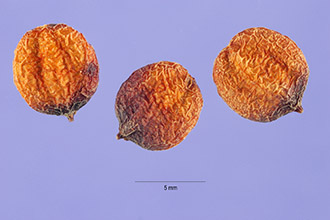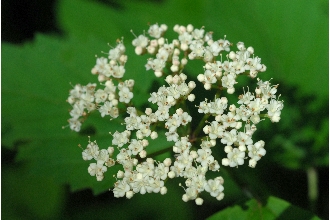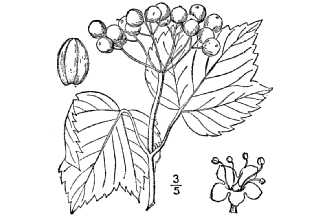Viburnum acerifolium L. var. glabrescens Rehder
Scientific Name: Viburnum acerifolium L. var. glabrescens Rehder

| General Information | |
|---|---|
| Usda Symbol | VIACG |
| Group | Dicot |
| Life Cycle | Perennial |
| Growth Habits | ShrubSubshrub, |
| Native Locations | VIACG |
Plant Guide
Alternate Names
Dockmackie, guelder-rose, maple-leaved arrow-wood, possum-haw, squash-berry
Uses
Deer, rabbits, mice, skunks, ruffed grouse, ring-necked pheasants, wild turkeys, and many species of songbirds eat the fruits of maple-leaf viburnum. Deer, moose, rabbits, and beavers eat the twigs, bark, and leaves. The relatively low-growing plants provide good nesting and escape cover for birds and small mammals. Maple-leaf viburnum has long been cultivated for its attractive summer flowers and foliage; then the autumn leaves turn rose-purple and contrast with the mature dark fruits. The plants will thrive in moist soils and a range of light conditions but they are a good choice for dry soils in deep shade. They can be used along forest edges, streamsides, and lakeshores.
Status
Please consult the PLANTS Web site and your State Department of Natural Resources for this plant’s current status, such as, state noxious status and wetland indicator values.
Description
General: Honeysuckle family (Caprifoliaceae). Native shrubs 0.5-2 m high, rhizomatous and forming thickets; twigs pubescent. Leaves deciduous, ovate or orbicular, mostly deeply 3-lobed, 5-12 cm broad, coarsely toothed, lower surface minutely black-dotted, nearly glabrous to thinly pubescent with stellate hairs. Flowers white, bisexual, 4-6 mm wide, in upright, flat-topped clusters 4-7 cm wide. Fruit berry-like (drupes), 6-8 mm long, nearly black, with a single stone. Botany Dept., NMNH, Smithsonian Institution @ PLANTS Variation within the species: No varieties are currently formally recognized within V. acerifolium – previous named varieties within the species have described vaguely discernible and widely overlapping geographic trends of morphological variation. V. acerifolium var. acerifolium V. acerifolium var. densiflorum (Chapm.) McAtee V. acerifolium var. glabrescens Rehd. V. acerifolium var. ovatum (Rehd.) McAtee Distribution: Widely distributed in eastern North America, New Brunswick (rare), Quebec, and Ontario south through Wisconsin, Illinois, and Arkansas to Florida and eastward into east Texas. For current distribution, please consult the Plant Profile page for this species on the PLANTS Web site.
Adaptation
Maple-leaf viburnum occurs in upland forests, hillsides, and ravine slopes. It grows best in well-drained, moist soils and is tolerant of acid soils. It requires partial shading for optimum growth and development and occurs primarily in mid- to late-seral communities. It is a common understory species in beech-maple forests in the northeastern and midwestern United States; along the Gulf coastal plain, it is found in rich deciduous woods, often with white oak. Flowering May-August; fruiting July-October.
Establishment
Maple-leaf viburnum begins seed production at about 2 years of age and produces abundant fruit every year. Most seeds have an impermeable seedcoat and embryo dormancy that requires a warm-cold stratification sequence to be broken.
Vegetative
reproduction through rhizomes is extensive.
Management
Low- to moderate-severity fires top-kill maple-leaf viburnum. It apparently survives fire by sprouting from underground rhizomes, but these are shallow and easily damaged and the species decreases with exposure to repeated fires. Viburnum leaf beetle: The viburnum leaf beetle (Pyrrhalta viburni), native to Europe and Asia, was first encountered in North America in 1947, perhaps arriving earlier from Europe on nursery plants. It received little notice until 1978, when it caused severe defoliation of ornamental viburnums in Ontario and Quebec. It has now reached western New York and Maine and become a concern in urban landscapes and nurseries. The adult and the larva “skeletonize” leaves by feeding on the leaves between the midrib and larger veins. Plants, which have been defoliated for 2-3 consecutive years, may be killed. The preferred host is Viburnum opulus and its selections; lesser damage is caused to V. lantana and V. rafinesquianum, V. dentatum, V. acerifolium, and V. lentago. Other species, particularly V. rhytidophyllum and V. carlesii, are relatively unaffected. The entire life cycle of the viburnum leaf beetle takes about 8-10 weeks. Larvae hatch in early May and feed on the viburnum leaves throughout the larval period, which lasts 4-5 weeks. The larvae pupate in the soil. The adults (4.5-6.5 mm long, brown) appear by mid-July and continue eating the leaves, then mate and lay overwintering eggs on the twigs. Egg-laying holes are in a straight line on the underside of the current season's growth. Chemical control of the viburnum leaf beetle is best applied to young larvae, because adults will fly away or drop to the ground if disturbed. If over-wintering egg sites are found, affected wood should be pruned and destroyed before the eggs hatch. Examine upper and lower leaf surfaces for feeding larvae. Potential biological control mechanisms are being studied. Cultivars, Improved and Selected Materials (and area of origin) These plant materials are readily available from commercial sources. Contact your local Natural Resources Conservation Service (formerly Soil Conservation Service) office for more information. Look in the phone book under ”United States Government.” The Natural Resources
Conservation
Service will be listed under the subheading “Department of Agriculture.”
References
Coladonato, M, 1993, Viburnum acerifolium, IN: W,C, Fischer (compiler), The fire effects information system [Data base], U,S,D,A, Forest Service, Intermountain Research Station, Intermountain Fire Sciences Laboratory, Missoula, Montana, <http://www,fs,fed,us/database/feis/> Donoghue, M, 1980, Flowering times in Viburnum, Arnoldia 40:2-22; Donoghue, M, 1983, A preliminary analysis of phylogenetic relationships in Viburnum (Caprifoliaceae s,l,), Syst, Bot, 8:45-58, Egolf, D,R, 1962, A cytological study of the genus Viburnum, J, Arnold Arb, 43:132-172, Friedlander, B,P,, Jr, 1999, Voracious viburnum leaf beetle munches into Ithaca area, Cornell Chronicle, <http://www,news,cornell,edu/Chronicles/6,17,99/leaf_beetle,html> Hauser, E,J,P, 1965, Characteristics and distribution of Viburnum (Caprifoliaceae) in Georgia, Bull, Ga, Acad, Sci, 23:(11 pages), Kessel, C, 2000, Viburnum leaf beetle, Pyrrhalta viburni (Paykull), in the nursery and landscape, Ontario Ministry of Agriculture, Food and Rural Affairs, Ontario, Canada, Web site, <http://www,gov,on,ca/OMAFRA/english/crops/facts/vlb,htm> McAtee, W,L, 1956, A review of the Nearctic Viburnum, Published by the author, Chapel Hill, North Carolina, Thomson J, & O, Thomson 1981, Leaf shapes of Viburnum acerifolium, Bull, Bot, Club Wisconsin 12:4-5, , Use soil moisture sensors to measure the soil moisture of Viburnum acerifolium L. var. glabrescens Rehder.
Fact Sheet
Alternate Names
Maple-leaf viburnum, maple-leaved arrow-wood, dockmackie, guelder-rose, possum-haw, squash-berry
Uses
Landscape: Mapleleaf viburnum is a native, thicket-forming shrub long cultivated for its good seasonal displays of creamy flowers, attractive summer leaves, dark mature fruits and reddish-purple fall color. It is adaptable to a wide range of light and soil conditions, is an excellent choice for dry soils in deep shade, and is useful for naturalizing along forest edges, streamsides and lakeshores. Wildlife: Mature fruits are eaten by a variety of wildlife including mammals, game birds and many species of songbirds. Its low-growing habit provides good nesting and escape cover for birds and small mammals.
Status
Please consult the PLANTS Web site and your State Department of Natural Resources for this plant’s current status (e.g. threatened or endangered species, state noxious status, and wetland indicator values).
Description
V. acerfolium is a native, thicket-forming shrub, 4 to 6 feet high and 3 to 4 feet wide. Twigs are pubescent (hairy). Leaves are deciduous and 2-5 inches wide, and most are deeply 3-lobed with coarse teeth on the margins. Lower leaf surfaces have minute black dots, and are nearly smooth to thinly stellate (having star-like tufted hairs). Small creamy-white, bisexual flowers in upright, flat-topped clusters 1-3 inches wide appear May through August. The 1/3-inch to 1/2-inch berry-like drupes are nearly black and appear July through October, often persisting into winter. Botany Dept., NMNH, Smithsonian Institution @ PLANTS
Adaptation and Distribution
Distribution , Use soil moisture sensors to measure the soil moisture of Viburnum acerifolium L. var. glabrescens Rehder.
Distribution
Mapleleaf viburnum occurs natively on hillsides and ravine slopes, as an understory shrub in upland beech-maple forests of the Northeast and Midwest, and in rich deciduous woods along the Gulf coastal plain. Optimum growth occurs in well-drained, moist soils, with partial shading; however, V. acerfolium is tolerant of acid soils, dry sites and deep shade. Mapleleaf viburnum is distributed throughout the East. For a current distribution map, please consult the Plant Profile page for this species on the PLANTS Website.
Establishment
Mapleleaf viburnum produces abundant fruit and seed yearly beginning at about 2-3 years of age. Most seeds have an impermeable seedcoat and embryo dormancy that requires a warm-cold stratification sequence for germination. The plant may prove difficult to propagate from seed. Vegetative reproduction is through rhizomes, or softwood cuttings (Dirr and Heuser, 1987).
Management
The plant’s suckering habit forms open colonies and it is best in a naturalized setting. In the native landscape, V. acerfolium may be damaged and decreased by repeated exposure to fires.
Plant Traits
Growth Requirements
| Temperature, Minimum (°F) | -28 |
|---|---|
| Adapted to Coarse Textured Soils | Yes |
| Adapted to Fine Textured Soils | No |
| Adapted to Medium Textured Soils | Yes |
| Anaerobic Tolerance | None |
| CaCO3 Tolerance | High |
| Cold Stratification Required | Yes |
| Drought Tolerance | High |
| Fertility Requirement | Low |
| Fire Tolerance | Low |
| Frost Free Days, Minimum | 115 |
| Hedge Tolerance | Low |
| Moisture Use | Medium |
| pH, Maximum | 7.5 |
| pH, Minimum | 4.8 |
| Planting Density per Acre, Maxim | 4800 |
| Planting Density per Acre, Minim | 2700 |
| Precipitation, Maximum | 50 |
| Precipitation, Minimum | 32 |
| Root Depth, Minimum (inches) | 14 |
| Salinity Tolerance | None |
| Shade Tolerance | Tolerant |
Morphology/Physiology
| Bloat | None |
|---|---|
| Toxicity | None |
| Resprout Ability | Yes |
| Shape and Orientation | Erect |
| Active Growth Period | Spring and Summer |
| C:N Ratio | Medium |
| Coppice Potential | Yes |
| Fall Conspicuous | Yes |
| Fire Resistant | No |
| Flower Color | White |
| Flower Conspicuous | Yes |
| Foliage Color | Green |
| Foliage Porosity Summer | Moderate |
| Foliage Porosity Winter | Porous |
| Foliage Texture | Medium |
| Fruit/Seed Conspicuous | Yes |
| Nitrogen Fixation | None |
| Low Growing Grass | No |
| Lifespan | Long |
| Leaf Retention | No |
| Known Allelopath | No |
| Height, Mature (feet) | 6.0 |
| Height at 20 Years, Maximum (fee | 6 |
| Growth Rate | Slow |
| Growth Form | Multiple Stem |
| Fruit/Seed Color | Red |
Reproduction
| Vegetative Spread Rate | None |
|---|---|
| Small Grain | No |
| Seedling Vigor | Low |
| Seed Spread Rate | Slow |
| Fruit/Seed Period End | Fall |
| Seed per Pound | 13100 |
| Propagated by Tubers | No |
| Propagated by Sprigs | No |
| Propagated by Sod | No |
| Propagated by Seed | Yes |
| Propagated by Corm | No |
| Propagated by Container | Yes |
| Propagated by Bulb | No |
| Propagated by Bare Root | Yes |
| Fruit/Seed Persistence | No |
| Fruit/Seed Period Begin | Summer |
| Fruit/Seed Abundance | Medium |
| Commercial Availability | No Known Source |
| Bloom Period | Indeterminate |
| Propagated by Cuttings | No |
Suitability/Use
| Veneer Product | No |
|---|---|
| Pulpwood Product | No |
| Protein Potential | Low |
| Post Product | No |
| Palatable Human | No |
| Palatable Graze Animal | Low |
| Palatable Browse Animal | Medium |
| Nursery Stock Product | No |
| Naval Store Product | No |
| Lumber Product | No |
| Fodder Product | No |
| Christmas Tree Product | No |
| Berry/Nut/Seed Product | No |


